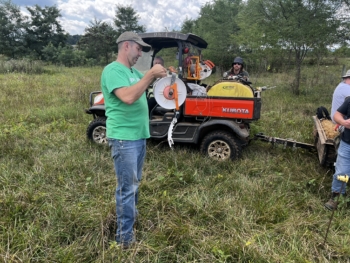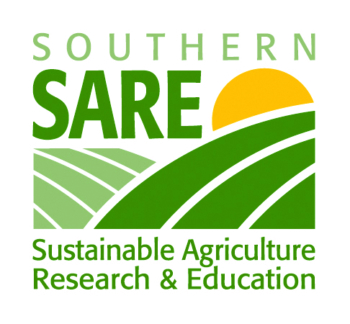Regenerative Grazing in the South: Case Studies from Virginia
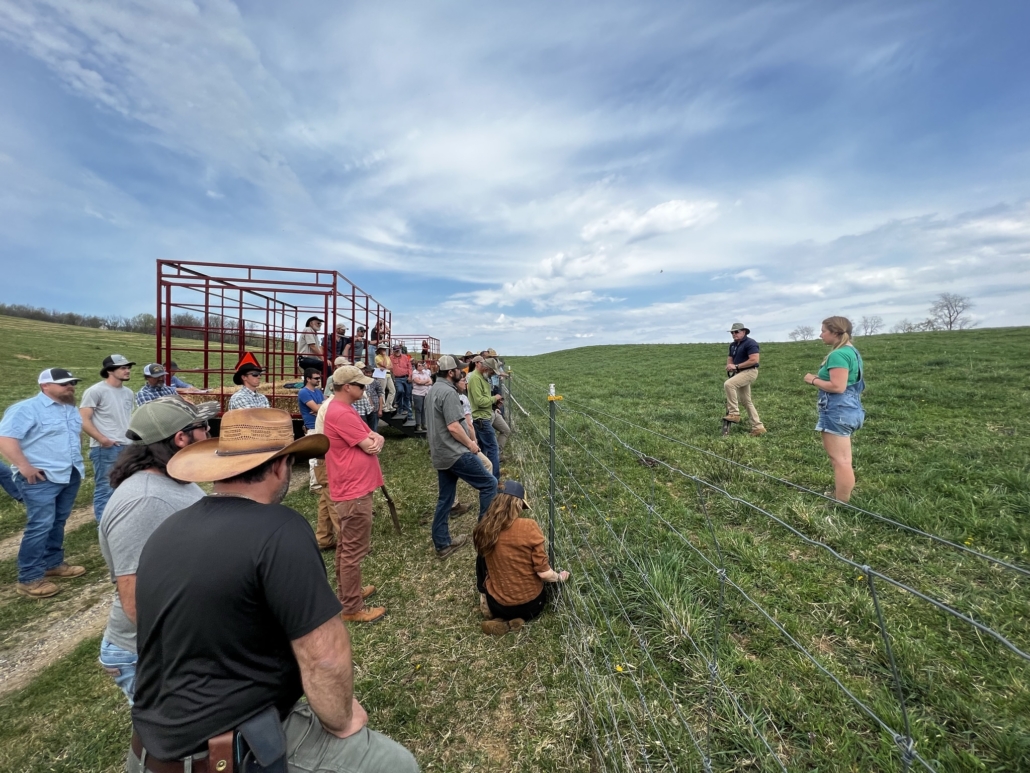
Becky Szarzynski of Ember Cattle Company and Dr. Allen Williams discuss grazing strategies at the 2023 Soil for Water/American Farmland Trust field days. Photo: Lee Rinehart, NCAT
By Lee Rinehart, NCAT Sustainable Agriculture Specialist, with contributions by Brent Wills, Virginia Association for Biological Farming; and Eric Bendfeldt, Virginia Cooperative Extension
Abstract
This publication tells the stories of five innovative Virginia livestock producers who are experimenting with new methods, finding ways to overcome obstacles, connecting with their communities, and supporting each other with mentorship and peer-to-peer learning. Together, these stories paint a picture of how regenerative grazing is spreading and gaining traction in Virginia.
Contents
Introduction
The Partners
The Farmers
Case Study: Ben Coleman
Case Study: Guille “Gil” Yearwood
TCase Study: Thad and Gayle Montgomery
Case Study: Sarah and Ralph Morton
Case Study: Sally Walker and Jason “JP” Pall
Conclusion
Reference
Further Resources
Introduction
Regenerative grazing that builds soil health and improves both water infiltration and storage holds great promise for livestock producers coping with unpredictable climatic conditions but has been slow to catch on in the southern United States. In 2021, the Southern Sustainable Agriculture Research and Education Program (Southern SARE) awarded a three-year grant to the National Center for Appropriate Technology (NCAT) for a project called Soil for Water, whose purpose was to accelerate the adoption of regenerative grazing in four southern states: Arkansas, Mississippi, Texas, and Virginia.
As the Soil for Water State Coordinator for Virginia, I (Lee Rinehart) had the pleasure of assisting Eric Bendfeldt, Virginia Tech Extension Specialist and leader of the project’s working group in Virginia. This publication highlights the work of that group, shares some of the lessons we learned, and tells the story of five Virginia farm families that have been diligently working to regenerate their land, strengthen their communities, and sustain their lifestyle in an era of uncertain weather, predatory land acquisition, and a lack of support for local markets. Together, these case studies provide a snapshot of the real-world experience of producers, the obstacles they face, and how the ideas and methods of regenerative grazing are spreading and gaining traction in Virginia.
Journeys of Resilience and Hopefulness: A Soil for Water Case Study Video Series from Virginia Tech
What does regenerative farming look like? What motivates some people to farm regeneratively, given the institutional and social pressures to maintain the status quo? And when a farmer begins a transition toward sustainable farming practices, what keeps them going?
Buck Holsinger explains the use of polywire at the Armed to Farm training at Holsinger Homestead Farm, August 2024. Photo: Lee Rinehart, NCAT
There is something engaging about the people who dedicate themselves to this agrarian lifestyle. Their stories, as told in a series of short films whose creation was led by Virginia Tech Extension Specialist Eric Bendfeldt, depict a beautiful hopefulness. They share an ethic of community as crucial to small farm viability, where the “farm” seems to extend beyond the farm gate and includes neighbors, townsfolk, friends, family, and all those who cherish the wholesome products these farmers grow. Moreover, these stories tell of a common ethos that may be one of the most potent motivations for adopting regenerative farming – the power of reconnecting to the land.
Leo Tammi, one of the farmers interviewed by Eric, exemplifies this reconnection. As he fostered biological diversity on his farm, he noticed in himself a “change of aesthetics.” It seems a reconnection to the land is reified most poignantly when the land reconnects with you.
View the Virginia Tech video series and follow the stories of these thoughtful agrarians:
- Adam Taylor and Eliza Spellman, Singing Spring Farm
- Becky Szarzynski, Ember Cattle Company
- Brent Wills, Bramble Hollow Farm
- Buck Holsinger, Holsinger Homeplace Farm
- Guille Yearwood, Ellett Valley Beef Company
- Jacob Gilley, Heaven Hollow Farm
- Jerry Swisher, farmer and retired Virginia Tech Extension Dairy Science Agent
- Leo Tammi, Shamoka Run Farm
- Mike Sands, Bean Hollow Grass-Fed Farm
- Sarah Morton and Ralph Morton, Cattle Run Farm
- Sally Walker and Jason “JP” Pall, Glade Road Growing
The Partners
Our Virginia working group addressed soil health, the basis of any good agricultural system, as the grounding principle in repairing, regenerating, and sustaining families and the wild communities with whom they share the land. Through this work, we put on 16 workshops, visited more than 20 farms, held five field days, produced 11 case study videos, held three regenerative grazing forums, and sponsored a completely new Regenerative Grazing track at the annual Virginia Association for Biological Farming Conference, which was attended by more than 600 people.
Two key partners in this project were Virginia Tech University and the Virginia Association for Biological Farming (VABF), both powerhouse organizations with a rich history of working collaboratively with farmers. These two groups served as state-based hubs to encourage peer-to-peer learning across a diverse group of organizations. We also worked closely with groups like the Virginia Forage and Grassland Council, Graze 300 Virginia, the Virginia Soil Health Coalition, and American Farmland Trust.
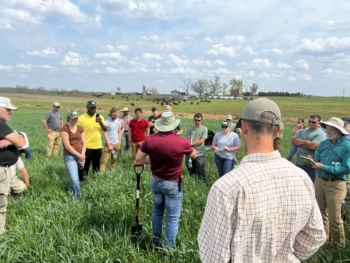
American Farmland Trust field day with Dr. Allen Williams at Brandy Station, Virginia. Photo: Lee Rinehart, NCAT
One of the highlights of this project was NCAT’s collaboration with American Farmland Trust. Working with Jacob Gilley, the Mid-Atlantic Sustainable Grazing Manager, and coordinators for AFT’s Sustainable Grazing Project, we brought Dr. Allen Williams of Understanding Ag, LLC in for two field days in Fairfield and Brandy Station that drew more than 150 farmers and graziers. According to Dr. Williams, it was a huge success. He said, after the field days, that educating farmers through peer events like these really pays off. As a project team, it’s sometimes hard to see the effect of your work, but interacting with farmers on the ground through this project has elicited huge interest, and many graziers are taking the next step toward regenerative grazing.
Eric Bendfeldt, Area Specialist for Community Viability with the Cooperative Extension Northern District Office, served as the project’s co-Principal Investigator. He brought his skillset in regional food systems and value chain coordination to bear in the development of a series of in-depth conversations with Virginia farmers who exemplify agroecological values in their relationship with the land, specifically in relation to regenerative grazing and soil health. The result was 11 videos, based on these conversations, to expand peer-to-peer learning and networking. It is our hope that these case studies can generate conversations on the opportunities and barriers to adopting a more regenerative agriculture.
Change happens when people connect one-on-one, as they did at the Allen Williams field days and through the efforts of groups like the Virginia Soil Health Coalition, which is an alliance of agencies, nonprofits, and Extension that works with farmers on the ground providing education and services, as well as providing a voice for farming folk. In fact, the farmers’ stories as related below are an outgrowth of the work done in Virginia by these groups. Brent Wills is doing this kind of work day in and day out in his capacity as program director for VABF and a Soil for Water partner in Virginia. He spent weeks on the road, visiting farms and graziers and walking the land and discussing the intricacies of soil health. When I was a county Extension agent in Montana, long ago, I found the most exciting way to engage with graziers was to get out on the uplands and get on our hands and knees looking at the plants from an insect’s level. It’s a whole new way of seeing when you are used to looking at a landscape from six feet off the ground. Brent did much the same, but went beyond plant counts to take land managers in Virginia on an adventure in discovering the world of living beings in the soil. Fitted out with shovels and soil probes, their expeditions yielded crucial information to graziers through an analysis of the diversity and population dynamics of the multitude of organisms that drive nutrient cycling. Brent’s work helped these folks appreciate the soil as the basis of their operation and provided them with data to make better grazing and nutrient-management decisions.
The Farmers
Case Study: Ben Coleman, Mountain Run Farm
Sedalia, Virginia
“There is no reason NOT to do this!”

Talking regenerative grazing with Ben Coleman at Mountain Run Farm. Photo: Brent Wills
Around 2007, Ben Coleman started noticing that everything on the farm was sick, including the cattle, the land, the community, and their finances. In the quest to redeem all the damage done by the first 10 years of conventional farming practices, the Coleman family has changed its management to a more holistic and regenerative model. Part of the drive behind this change was to bring ecological balance to the land, and Mountain Run Farm is now seeing those benefits in real time. For the past three years, the Colemans have worked with representatives from the Virginia Breeding Bird Atlas to survey the return of more than 100 species of birds that are not normally seen in this region and invite back species that have been decimated by habitat destruction.
Mountain Run Farm is a pasture-based farm selling custom grass-fed/grass-finished beef in Bedford County, Virginia. Grazing management and soil health have become a focus for the Coleman family, who took over the 1,000+ acre farm in 1991. They operated the farm with conventional methods until around 2007, when they reduced chemical applications on crop and pastureland. In 2010, the Colemans sold all hay equipment, and the year-round grazing adventure began, with support from mentors like Ian Mitchell-Innes and Greg Judy. Since then, the farm has transitioned to a successful year-round grazing operation with several herds of grass-only beef cattle and has not purchased off-farm fertility or seed stock since 2007. Ben has not fed any hay to the herd at all in the last five years.
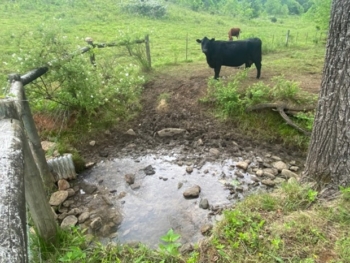
Limited-access watering hole for cattle. Photo: Brent Wills
Ben started to learn more about holistic and regenerative grazing and realized that he was in a place where the only option to survive on the farm was to let go and start over. Certainly, a more sympathetic approach than “get big or get out.” He started calving with naturally adapted ruminants in the region to align his calves with the best available forages and reduce the need for intervention. Seeing the health benefits of his herd and reduction in losses from calving, Ben knew he was on the right track and continued to breed and select for the best calves that thrive on grass.
The livestock at Mountain Run Farm are carefully rotated around the farm based on a holistic grazing management plan, according to forage availability, seasonal changes, and management observations. Portions of the farm had off-stream livestock watering installed 20 years ago, but most of these structures were broken or not in use due to poor placement. To fully respect the ecosystem and the relationship between the land and livestock, Ben permits careful grazing of riparian areas and streams. This helps rejuvenate and heal those natural areas at the common boundary of the domestic and wild realms.
Ben’s work at Mountain Run exemplifies the ethic of care by listening to the land through observation and adaptation, instead of the ubiquitous heavy-handed approach of employing machinery and chemicals to make the land do something it wasn’t intended to do.
Case Study: Guille “Gil” Yearwood, Ellett Valley Beef Co.
Montgomery County, Virginia
Mentoring New Graziers
“If you always leave grass behind, you never run out of grass.” This was an observation Gil had back in the 1980s, when he began his transition from continuous grazing to a rotational system. “I’ll never forget that day years ago when I went back to a grazed paddock a week later and saw regrowth.” It was something he’d never seen before. “When you graze a pasture continuously, you have no idea how much grass you have because it’s continually disappearing.” After Gil switched to rotational grazing, his paddocks would “look like a hayfield” four weeks after grazing. This, in his words, “was totally different and totally better.”
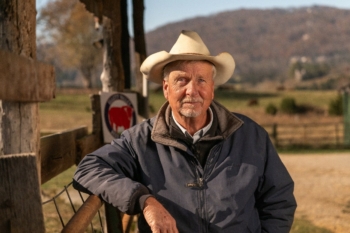
Guille Yearwood. Photo: Ernie Didot, Clear Impact Productions
Ellett Valley Beef Company encompasses several locations around Blacksburg, Virginia, on which Gil grazes South Poll beef cattle—a total herd of around 350 animals. He relies on grass alone and follows adaptive management techniques with frequent moves, mostly daily, and recovery periods of 70 to 90 days to allow for full plant recovery before the next time cattle see the paddock. He considers his system to be truly regenerative. In fact, he started regenerative grazing long before the term came about, and he’s glad it did, “because it’s a good term.” It accurately describes his way of doing business. His regenerative practices include highly diverse pastures, grazing for animal impact and nutrient cycling, and long recovery periods for plant rest and accumulation of high amounts of organic matter to the soil.
Forming New Land Stewards
Gil is a natural educator, and if there’s no one to share his experiences with, he finds someone. And he has an effective, human-centered system that works well to help new farmers gain a footing. “The big challenges a new farmer needs to overcome are the tactile, physical problems. These are harder for people to pick up than we realize. For instance, a polywire reel is a foreign object to a beginner, but for me, it is an ordinary tool like a screwdriver.” Gil helps beginners by simply taking them out and involving them in moving cattle, checking cows, or moving polywire, and showing them how to shut off the power, tie polywire, or set posts. Newcomers are fascinated by the complexities of grazing tools and procedures, and he has come to understand how new this is to some people, so he trains people from this tactile perspective. Also, since new farmers don’t know cattle, and, given the long learning process to understand livestock behavior, his advice is to read all the books you can at night and during the day, go to the stockyard. Seriously, the stockyard. When a cow comes into the pen, evaluate her breed, condition, and weight, and especially listen to the people talking around you and pay attention to what they are observing.
“A lot of [the mentees] are small-scale and interested in an agrarian lifestyle,” Gil observes. It became clear to him that the most important thing for them was to become smart financially. “For most small-scale producers, lifestyle takes precedence over money. So, you have to enjoy it.” For instance, a prospective mentee would assume they needed to buy heifers, but Gil recommends buying cows, which are less problematic and better for beginners. “Perhaps buy steers to graze through summer to see if you like it. And, importantly, keep it fun,” says Gil. “Avoid those things that cause stress.”

Pastures at Ellett Valley Beef Co. Photo: Guille Yearwood
Gil recalls one young man, a particularly engaged fellow whom he mentors. He eventually took over one of Gil’s commercial herds. “He’s a better grazier now than I am, more willing and committed,” notes Gil. “He went from zero experience to an accomplished grazier.” Like this young man, many of the mentees come onto Gil’s farm to practice. Each mentee is different, so Gil’s approach is different. He may say, “you come up and I’ll show you around the farm,” or, “you buy these cattle and I’ll answer your questions… whether you buy cattle or not.”
“I know I’m not the only one doing this. I didn’t invent this; just filling a need,” says Gil about his informal mentor system. And his advice to new graziers: “Don’t panic – things are going to happen, and if something does, it’s not the end of the world. Maybe there’s not enough grass one day, so you are going to miss the rotation. Things like this still happen to me after all these years, so relax, you’ll make up for it. Don’t be afraid to set the field up and try it; if it doesn’t work, adjust and move on.”
Case Study: Thad and Gayle Montgomery, Double M Dairy
Wirtz, Virginia
Regeneration is Community
Double M Dairy is one of the few remaining family-owned-and-operated dairies in the region, mainly due to the family’s independence over the past few generations and a practical perspective of farming. Owners Thad and Gayle Montgomery currently milk 60 cows on herdshare and produce over 1,500 gallons per week for customers in southwest and central Virginia. The farm raises 50 replacement heifers on grass, as well as 50 dairy steers for slaughter at the local USDA plant for retail sale at their on-farm store. The store, Melvin’s Farm to Fork, is named after Thad’s father, who started the land on its regenerative path. The Montgomerys also raise 12 to 15 pastured hogs, keep 400 pastured laying hens for eggs, and carry products from more than 40 local farms in the store, from chicken to produce and cheese to honey. What lit the fire for the Montgomerys to farm the way they do was the realization that the milk they produced was far better than conventional milk, and they felt that the cost of production would be lower than any conventional system if they could convert to perennial pastures and as little grown ‘feed’ as possible. They knew it would be a journey, and they now realize that their customers, particularly at Melvin’s, have taken that journey with them.
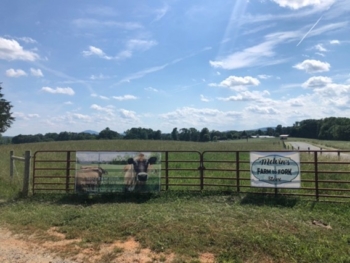
Entrance at Double M Dairy. Photo: Brent Wills
Thad is the third-generation owner/operator of Double M Dairy, having started the transition to ownership in 1995. After family divides and health issues, he took over with Gayle in 2015, when Melvin passed away. But Thad knew the knowledge that his dad had provided to him over his life on the farm would help him make the transition he knew he needed to make. The best advice Thad gives to new and open-minded farmers is “everything you have learned is wrong,” especially after seeing the improvements he has seen in his journey so far. The farm has been no-till since the 1970s, long before it was cool to be no-till, and Thad says that crop fields have grown cover crops his entire life, again, long before that was a thing. Wheat, barley, crimson clover, and vetch have been favorites to help with weed suppression and nitrogen building because Thad understands how beneficial they are to overall soil health.
The transition to a grass-based dairy began in 2011, using annuals, but the focus was on being perennial forage-based, and they accomplished that by 2017. Thad converted 55 acres of cropland to pasture in 2021 and 20 more acres in 2023, with a goal of 56 more in 2024, totaling 316 acres of pasture and 50 acres of double-crop cropland for 80 mature dairy cows, 50 young stock (<12 months), 50 yearlings (13 to 30 months), 400 laying hens, and 15 hogs.
[caption id="attachment_168603" align="alignleft" width="440"]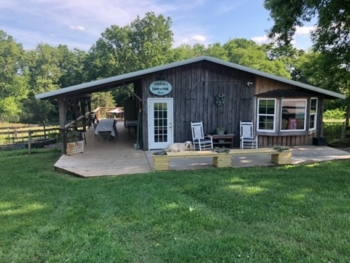 Melvin’s Farm to Fork store at Double M Dairy. Photo: Brent Wills[/caption]
Melvin’s Farm to Fork store at Double M Dairy. Photo: Brent Wills[/caption]
But is it economical? They originally moved into grazing to cut costs, but after meeting the industry benchmark of 1 million pounds of milk per man for six years, realized that costs can only go so low. They began to look at marketing to increase margins. The ideas of perennial pastures and an on-farm store were born. By 2016, the farm was 10% perennial-based; by 2019, it was 40%. Currently, in 2024, they are 60% perennial and will be 90% by next year. Thad went from planting a seven-way perennial mix to a 13-variety blend for pasture and says that he is currently trying to really understand rest periods for his forages, allowing him to build soil health and resilience in what is typically a very high-maintenance, high-input system – maintenance and input he no longer needs to rely upon. The past few years have seen Thad working to increase fungal populations to correct imbalances and achieve better nutrient density for the foods they produce on-farm, to bring healing to their customers as well as the land.
In response to the COVID-19 pandemic, Melvin’s Farm to Fork began in 2020 as a simple herdshare selling milk to dozens of members of their own community. In just four years, they have seen Melvin’s grow to serve a much wider customer base, coordinating drop spots with partners Robby and Erin Lizenby to deliver Sweet Land milk, as well as other farm products, all over Virginia. They are building a network of customers and improving the reach and impact of local, regenerative farm products in the Commonwealth.
Case Study: Sarah Morton and Ralph Morton, Cattle Run Farm LLC
Greene County, Virginia
Tradition and Adaptation
Ralph Morton and his sister Sarah Morton raise cattle, chickens, produce, blackberries, hogs, cows, and more on Cattle Run Farm, the farm their parents once owned and farmed. They have benefitted from the extensive farming knowledge of their parents and grandparents and have been active members of Minority Veterans of the Piedmont, where they provide peer-to-peer education with minority farmers.
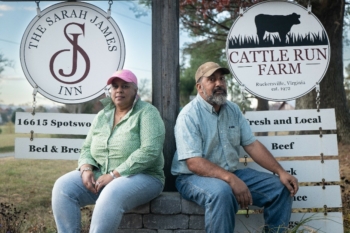
Sarah Morton and Ralph Morton. Photo: Ernie Didot of Clear Impact Productions
“Our journey started back in early 1919 with my grandfather on my mother’s side,” says Sarah. “Farming is in my genes both on my paternal and maternal sides. And you know, it’s pretty powerful to know that our parents and grandparents were able to acquire the land. We’re now third generation on both sides and we are the only family that’s farming on my mother’s side.” But, she continues, “On my dad’s side, I have other brothers and cousins that farm. My grandfather farmed 147 acres and sharecropped over 1,000.” Her grandfather on her dad’s side farmed more than 500 acres. He was a contractor, had a third-grade education, and was a resilient man and a servant leader in the community, which set the bar for the life that Sarah and Ralph are building on Cattle Run Farm. Resilience with limited resources is a must for small farmers in Virginia, with all that is set against them in a commodified world.
Times change, and Cattle Run Farm had to adapt. “When my father turned the farm over to us in 2011,” Sarah realized they could no longer operate in the way her grandfather did if they wanted to farm sustainably. For that, they had to achieve a viable farm scale. She and Ralph identified infrastructure and diversification as the key elements that needed improvement to maintain their business and lifestyle. “So, one of the things we looked at was a map of the current assets we had,” Sarah remembers. “In order for us to move to another level, we had to address infrastructure. We did not have the infrastructure that we currently have now. We’re continuing to improve on that. But infrastructure is so important for the sustainability of farms.”
Their asset map also made clear they needed to diversify. “We had beef cattle, we had land and a homestead. So, we just looked at our current assets and asked, how can we convert them into additional profit?” That’s when they converted the homestead into an Airbnb, which they named after their mother and father. The Sarah James Inn now provides income as well as a connection with the community. “We then went to a value-added side with the meat, where we increased income and further customer connections.” When Sarah was young, her first farm project was pigs, so, with that experience, she reintroduced pork production into the farm. “We have now added value with our beef products, our pork products, and our berry products.” Sarah and Ralph are experiencing benefits of diversification, in soil, crops, animals, and their market options. These have provided them with something industrial agriculture cannot: community. And, the benefits of their resilient farm accrue well beyond their farm gate, impacting their landscape, watershed, and community.
Case Study: Sally Walker and Jason “JP” Pall, Glade Road Growing
Montgomery County, Virginia
An Agrarian Vision
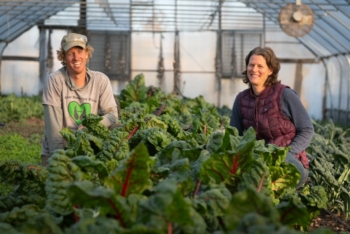
Sally Walker and Jason “JP” Pall. Photo: Ernie Didot of Clear Impact Productions
Sally and JP have been farming at Glade Road Growing for 13 years. They didn’t have much agricultural experience when they started. As Sally recalls, “My husband had interned on another organic farm in the area, and he really enjoyed it. And I had finished school but was having trouble finding a job. After a lot of looking around, my husband said, ‘Well, why don’t we try to start a farm?’” She hadn’t given it serious consideration up to that point but realized, in an experience most of us can relate to, “nothing else was really presenting itself.” Possibility emerges in such instances. Soon, and serendipitously, they met someone who had recently purchased some property. Beautiful, yes, but no infrastructure. Basically, it was “just a cattle field.” But Sally and JP saw potential in that grassy meadow.
They started small. Very small, actually. “Our very first area when we started was probably about the size of a home garden,” Sally remembers. “And for what we didn’t know, we went to winter conferences.” They read books. They watched YouTube videos. And they visited a lot of other farms. Each year, they would try something they had read about or seen on a neighbor’s place.
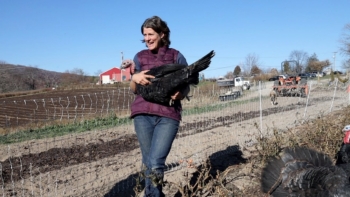
Sally Walker. Photo: Ernie Didot of Clear Impact
Productions
The evolution of Glade Road Growing is a story of determination seasoned with a cautious scrutiny of risk. Sally and JP were careful to never overextend themselves. They slowly added enterprises and built a customer base. “Our very first year,” Sally says, “was maybe the only year we just had vegetables, and in our second year we added 20 to 30 mixed-breed broilers. We processed them ourselves and sold them to customers who were interested.” Like their vegetable enterprise, the number of broilers on the farm grew a little each year, and soon they were adding other animals to the mix. “We added in laying ducks and then we added in Thanksgiving turkeys and meat ducks and laying hens.” Now, the farm offers customers a diverse selection of vegetables, poultry, and pork.
Sally and JP’s vision is one of self-sufficiency. “I think maybe it starts with just being selfish like my husband and I,” Sally muses as she considers their motives. “We just really want to be outside, to work together.” And it’s important for their children to connect to a place. Humans need to connect, to know and experience meadows and insects and where food grows. “This profession allows us to really make ourselves happy,” Sally reflects. “I’ve asked my husband, why do we do this? There are other jobs working outside where you would make more money.” The answer is obvious and impactful: there’s autonomy in farming, but you must plan, start small, and build a community. “The customers just love it,” says Sally, it’s “like they’re cheering you on the whole way.” The connection comes full circle because they are providing something meaningful to the community, and, in JP’s words, “that is so important on that level.”
Take-home Messages from the Virginia Working Group
- Don’t be afraid to let go of things that don’t bring health to the land and profitability to the bottom line.
- You have no idea how much forage your pastures can produce if you graze continuously with little or no recovery time because the forage is continually disappearing.
- Don’t panic when something goes wrong. Things are going to happen, and if something does, it’s not the end of the world. Don’t be afraid to set up a grazing system and try it; if it doesn’t work, adjust and move on. With the integrity to keep going, things generally work out.
- Many times, what we have learned before beginning the regenerative journey can be an impediment to successful grazing. The improvements you make over time will be evidence of your success.
- Seek to achieve a viable farm scale. Determine the key elements that need improvement to maintain your business and lifestyle. Look at your current assets and ask yourself how you can convert them into additional profit.
- Building healthy soil, limiting off-farm inputs, and being frugal with expenses all help establish resilience.
- Start small. Seek out a mentor and attend winter conferences. Read books, watch YouTube videos. And visit a lot of farms. Then, try something different every year, based on what you’ve learned.
Conclusion
I have worked in many states and regions, walking the land with farmers and ranchers, talking at dinner tables. I’ve laughed at their jokes and have been saddened by their failures. But I think I know why they do this—why they take on the risk of being a farmer in an age where big companies, big farms, and big ideas of efficiency take precedence over community. I also think there’s something powerfully rejuvenating to the human spirit in the “failed attempt.” We have a common human striving; our eyes are always on the horizon. Like Rainer Maria Rilke’s “let everything happen to you: beauty and terror, just keep going, no feeling is final,” we are compelled to work toward our vision, whether it succeeds or not. This, I think, is part of what makes up the psychology of a radical farmer. They have a vision and have chosen one of the most difficult of paths to see it to fruition. And for most of them, the path is what brings the most joy.
The stories retold here represent the experiences of many people of the land in Virginia who are working to build meaning and sustain their livelihoods. And, for some, they’re about taking a new path toward self-sufficiency. What is common to them is the substrate of life, which is the soil we are all bound to. Like the mycelium that connects plants and microbes in the soil, we are an extension of the myriad communications within and are the virtual embodiment of the soil’s rich ecology. These stories, I hope, will serve as a reminder that change toward more resilient, regenerative, soil-centric, community-oriented farming is possible, even when the forces against it seem overwhelming.
Virginia is an agricultural state, if you look at industry numbers. Farm products are the leading source of economic revenue in the commonwealth, leading with broilers. Then there are the subsidiary products that support poultry production; namely, acres and acres of corn and soybeans. But beyond the veil of these commodities are the small farms that are driving rural and community development. In 2022, statistics show that 32,456 of Virginia’s farms had sales of $50,000 or less, but these small farms accounted for 83% of all farms in the state (USDA, 2024).
The Soil for Water project work done in Virginia gave me insight into how these farms are supported with information, peer-to-peer learning, and market assistance. And there’s a lot of help for the small farmers in this state, thanks to a wide coalition of farmers, nonprofit organizations, agency people, and food advocates. There are almost too many to mention, but the success of these affiliated organizations is held together by a few key organizations. Virginia State University Small Farm Program, The Virginia Tech Extension 4 The Soil program, the Soil Health Coalition, and the Virginia Association for Biological Farming are all key players that work with grazing groups, co-ops, farmer alliances, industry groups, and USDA to provide meaningful support, such as mentoring, technical assistance, and conservation programs that benefit the land while supporting good production practices that positively impact a farmer’s bank account.

Lee Rinehart, Kara Kroeger, and Brent Wills at Mountain Glen Farm, Raphine, Virginia.
Photo: NCAT
I visited farms and ranches in Virginia during the three years of this project and saw the impact that can be made when community building and farm resiliency are practiced through shared resources. If I were asked, “What is the one element that is making the small family farm more viable in Virginia?” I would undeniably say it is the presence of an organized coalition of groups—unusual in the South—characterized by the Virginia Soil Health Coalition, which is facilitated by Virginia Tech Extension. They have the time and expertise, especially in their coordinator, Mary Sketch Bryant, to bring a disparate group of engaged organizations together for collaboration and joint project development. This, I believe, is the crucial attribute that could be replicated in other states that lack a more-defined small-farm movement. A dedicated budget, a competent facilitator, and diligence in communications are really all it takes to make a coalition work.
The stories told here are all oriented around the soil and community—elements of a sustainable agriculture vision that is being manifested in small pockets across the country, redefining how Americans relate to the land. We have met Ben Coleman, who is rejuvenating and healing the natural areas at the common boundary of the domestic and wild realms where he lives. There’s Gil Yearwood, who is encouraging young people to take up grazing as an act of resilience, advising them with his gentle nature to “not panic.” We met Thad and Gayle Montgomery, whose journey started when they realized “everything they had learned before was wrong,” and then went on to build a resilient farm. And Sarah and Ralph Morton, who embraced their tradition while reaching out and adapting to new circumstances by embracing community and social and ecological diversity. Finally, we met Sally Walker and JP Pall, whose agrarian vision led to the slow, conscientious development of a small, diversified farm that has come to matter to so many of the people who buy from them. Soil is the basis for community, and stewardship of the soil naturally grows into stewardship of community.
Reference
USDA. 2024. USDA Releases 2022 Census of Agriculture Data. USDA NASS, Virginia Field Office.
Further Resources
Soil for Water
NCAT’s Soil for Water project website celebrates the amazing water-holding ability of healthy soil and encourages on-farm research and discovery. It includes a story collection, peer-to-peer learning opportunities, and resources for farms and ranches interested in catching and holding more water in their soils.
Managing Soils for Water: How Five Principles of Soil Health Support Water Infiltration and Storage
Too often, the approach to dealing with water deficits has focused exclusively on better technology: deeper wells, better drip emitters, more efficient micro-sprinklers, and variable-speed drives on pumps. While all of these are important, this ATTRA publication discusses a different approach that focuses on maintaining healthy soils by following five basic principles.
Grazing Networks for Livestock Producers
Grazing networks promote a mutual self-help approach to learning that is based on shared local experience and provides several benefits to participants. This ATTRA publication offers suggestions for finding or starting a grazing network and provides examples of the kinds of activities grazing networks might conduct. It also contains recommendations for sustaining a grazing network over time.
Virginia Soil for Water Partner Organizations
Virginia Association for Biological Farming
Key Organizations Supporting Regenerative Grazing in Virginia
Mountains-to-Bay Grazing Alliance
Virginia Assn for Biological Farming
Virginia Forage and Grassland Council
Acknowledgment
This publication is based upon work that is supported by the National Institute of Food and Agriculture, U.S. Department of Agriculture, under award number 2020-38640-31521 through the Southern Sustainable Agriculture Research and Education program under subaward number LS21-345. USDA is an equal opportunity employer and service provider. Any opinions, findings, conclusions, or recommendations expressed in this publication are those of the author(s) and do not necessarily reflect the view of the U.S. Department of Agriculture.
![]()

